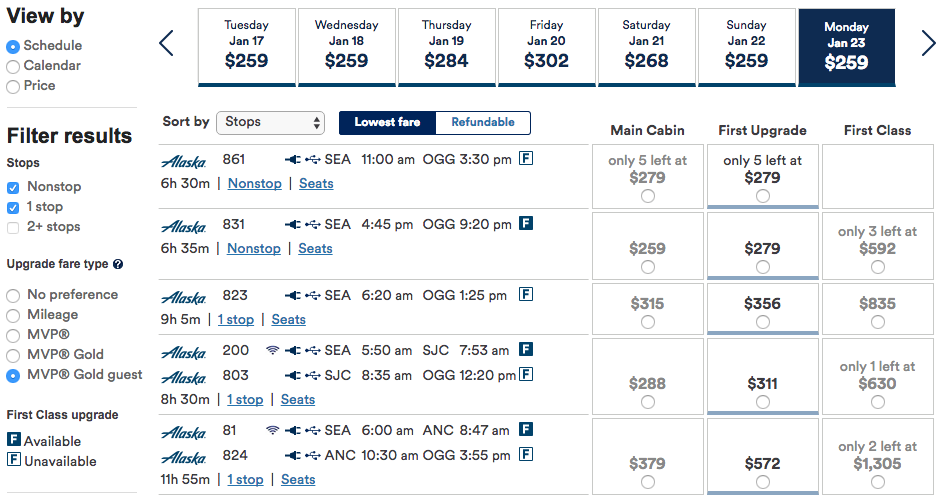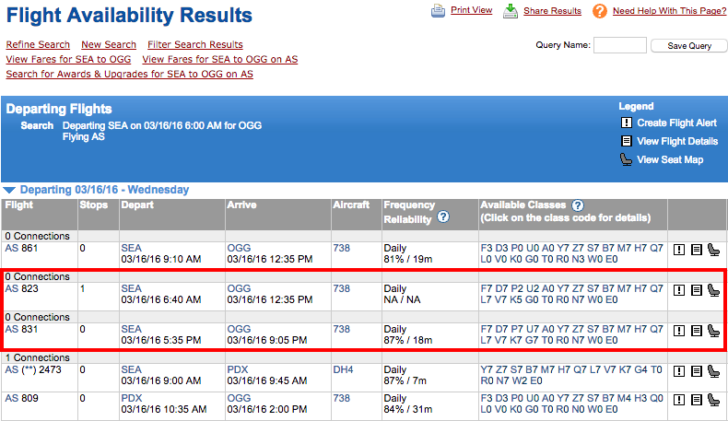Last week I quickly summarized the order of complimentary elite upgrades on each of four major U.S. carriers. Several readers asked me to go into more depth on how these complimentary upgrades stack up against other forms of upgrades, such as those for full-fare tickets or those which rely on miles and upgrade instruments. I’ll discuss each carrier individually, starting with Alaska Airlines because its system is comparatively simple.
- Ultimate Guide to Alaska Airlines Upgrade Rules
- Ultimate Guide to United Airlines Upgrade Rules
- Ultimate Guide to American Airlines Upgrade Rules
- Ultimate Guide to Delta Air Lines Upgrade Rules
Searching for Upgrade Inventory
Alaska Airlines uses the same fare class, U, for all upgrade inventory. Whether you can actually upgrade your ticket depends on the fare class you purchased, the availability of U inventory, and the availability of miles/cash/coupons to process the upgrade.
Alaska makes it easy to see U inventory on its website, although a website change means it no longer appears as a “U”. Instead it’s a white “F” on a blue background. If there is no upgrade inventory, then the “F” becomes blue on a white background.
Be aware that the “Upgradeable” fare price will change depending on which type of upgrade you select, but you will also be able to see the regular, lowest main cabin price to the left.

Because some upgrades require purchasing a more expensive fare, Alaska will display this price in the “First Upgrade” column. It also displays the lowest fare in the “Main Cabin” column to the left so that you know how much more you’re paying in order to upgrade the ticket.
First class fares are displayed to the right in case you decide it’s easier to just buy first class rather than upgrade a coach ticket. Sometimes a discounted first class ticket is a better deal than an upgradeable main cabin ticket because the upgradeable fare also has other benefits, like more flexible change policies.
In the example above, the cheapest fare to Maui is $259 (flight 831) but an upgradeable fare is $279. This is an instant upgrade for an MVP Gold Guest upgrade, which means I need to have one of these upgrade codes. The cost of an upgradeable fare might change if I select a different upgrade type from the sidebar.
You can still book an upgradeable fare if there is no upgrade space available. That way your flight is eligible if an upgrade becomes available later. Remember we’re only talking about advance, immediate upgrades here. You don’t need to buy a more expensive fare to be eligible for a complimentary upgrade at departure.
Finally, you can find Alaska’s upgrade inventory using tools like ExpertFlyer. Either perform an upgrade search to display U inventory only, or perform an ordinary search that will display paid fare classes alongside the U fare class.

Upgrades for Award Tickets
All upgrades are now processed in order of fare hierarchy, which means more expensive and less restrictive tickets get upgraded before cheaper, highly discounted tickets. This is similar to how most airlines work.
A few airlines also upgrade award tickets, but usually at the very end. What’s unusual about Alaska Airlines is that some of the more expensive award tickets (which cost more miles and have better availability) also get priority, just like more expensive paid tickets.
A very important point is that not all award tickets are processed last. They are actually spaced out in the fare hierarchy. I’ve copied the same hierarchy above and highlighted the award fare classes. T
Order of upgrades (from first to last): Y, Z, S, B, M, H, Q, L, V, N, K, G, T, R, W.
The Z and N fare classes that I highlighted in red above are more flexible, refundable award tickets. Z fares are even more expensive than N fares, so they have greater priority. W fares are the regular, most restrictive award tickets. They are upgraded last.
Upgrades for Full Fare Tickets
Instant, confirmed upgrades are available to MVP, MVP Gold, and MVP Gold 75K elite members when they purchase certain fare classes. These do not necessarily need to be Y fares (the most expensive type). No miles, coupons, or other redemption needs to be made to claim these upgrades — it’s simply a benefit of buying a more expensive fare.
- MVP Gold 75K members can upgrade Y, S, B, M, H, and Z fares.
- MVP Gold members can upgrade Y, S, B, M, and Z fares.
- MVP members can only upgrade Y, S, and Z fares.
You can search for these different upgrade types Alaska’s website by indicating you want an “MVP upgrade” or “MVP Gold upgrade.” Note that instant upgrades do not apply to companions without their own elite status.
Upgrades to Premium Class
Alaska Airlines introduced premium class in 2017, and the upgrade process is very similar to first class upgrades. Some fares are eligible for an instant upgrade. Others will qualify for a complimentary upgrade only if the first class upgrade fails. The following fares are eligible for an instant upgrade to premium class:
- MVP Gold 75K members can upgrade all fares.
- MVP Gold members can upgrade Y, S, B, M, H, Q, L, V, K, Z, and N fares.
- MVP members can upgrade Y, S, B, and Z fares.
Upgrades with Instruments and Coupons
MVP Gold and MVP Gold 75K members receive four Gold Guest Upgrade coupon codes each year, although there are occasional offers to earn more than this. These upgrades may be used for your own travel or for any other person flying on Alaska Airlines, even those without elite status. Upgrades must be redeemed for travel that occurs on or before their expiration date.

Gold Guest Upgrades can be applied to Y, S, B, M, H, Q, L, V, and K fares (this list excludes only G, T, and R fares). Connecting flights are permitted to use the same Gold Guest Upgrade so long as they are separated by no more than four hours. In the event your flight is cancelled or changed, the member who originally earned the upgrade may call Alaska to request that it be returned to his or her account.
Upgrades with Miles
One-way upgrades are available for a flat rate of 15,000 miles and include connecting flights separated by no more than four hours. Your ticket must be booked in the Y, B, S, M, or H fare class to be upgraded using miles.
Complimentary Elite Upgrades
Complimentary elite upgrades are ranked solely by elite status and the time the upgrade request was made. Companion upgrades (available for MVP Gold and 75K members) are treated as if the companion has the same elite status as the elite member, and because the request is made at the same time the companion should come immediately after on the waitlist. Any change to your itinerary will require a new upgrade request and will change your priority on the waitlist.
The number one thing you can do to improve your chances at an upgrade is to book and request your upgrade as soon as possible. Because MVP Gold and 75K members can cancel or change their tickets at any time without penalty, speculative reservations might be the way to go. (Non-refundable tickets are still non-refundable, but you get the full value to use for a future flight.)
Upgrades at the Gate
Paid upgrades start at $50 and go up with distance (taxes apply to the upgrade fee). These upgrades can be requested at check-in or at the gate if you do not already qualify for a complimentary elite upgrade.
- 0 to 1,250 miles — $50
- 1,251 to 2,500 miles — $100
- 2,501 to 3,750 miles — $150
- 3,751 miles and above — $200
To put this in perspective, a non-stop flight to Hawaii is roughly 2,600 miles and would only cost $150 each way. However, Alaska uses the entire trip distance (including connections) to determine the cost. Upgrading your one-way journey could cost more depending on your itinerary.
Priority for Each Upgrade Type
Alaska Airlines doesn’t allow any upgrades except complimentary elite upgrades to be entered in a waitlist or queue. This means that unless you confirmed your upgrade in advance, you will be assigned to the complimentary elite upgrade waitlist as your flight nears departure. This is the waitlist priority at the gate; passengers within each group are sorted by time of request as the only factor:
- MVP Gold 75K and companion upgrades, based on fare class
- MVP Gold and companion upgrades, based on fare class,
- MVP upgrades, based on fare class
- Paid upgrades requested at check-in/gate
You must request a complimentary elite upgrade to be on this waitlist. However, you can’t be on the waitlist when you try to apply an instant confirmed upgrade. If you tried to confirm an upgrade in advance and failed for any reason, make sure you go back to your reservation online and request the complimentary upgrade. (Assuming upgrade space becomes available later and you want to try again, you can call an agent to take you off the complimentary upgrade waitlist.)
If all complimentary upgrades have cleared, then Alaska will offer upgrades at check-in or at the gate to other passengers without elite status, using the fee schedule described above. Personally I have never seen this happen. You might have better luck if you go up to the agent and request an upgrade rather than waiting for an announcement.
